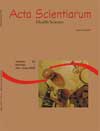<b>Neurocysticercosis prevalence in patients assisted at the neurology sector of the Hospital Universitário Regional de Maringá, state of Paraná, Brazil</b>- DOI: 10.4025/actascihealthsci.v29i1.111
Abstract
Register books of ambulatory patients and of the ones in hospital, assisted at the neurology sector of the Hospital Universitário Regional de Maringá, State of Paraná, from January, 2000 to June, 2003, were evaluated with the purpose of estimating the neurocysticercosis prevalence. Out of the 1,713 individuals attended, 13 (0.8%) patients were given the diagnosis of neurocysticercosis. In four patients, such a diagnosis was established during the study period, and the others were evaluated from 1993 to 1999. Concerning sex, the prevalence of neurocysticercosis was of 0.8% in males and 0.7% in females. As for age, the prevalence was greater in 11-30-year-old patients (1.3%) and in individuals who were above 50 years old (1.2%). With respect to the municipal districts that presented cases of neurocysticercosis, Ângulo, Marialva, Floresta and Mandaguaçu showed the greatest prevalence. Epileptic crises and headaches were the main complaint of the diagnosed patients. The observation of one active case and of a transitional one, among the four cases diagnosed in the study period, indicates that the infection is still active in our environment and that it deserves a constant vigilance from the sanitary authorities.Downloads
Download data is not yet available.
Published
2007-12-18
How to Cite
Moitinho, M. da L. R., & Dacome, S. (2007). <b>Neurocysticercosis prevalence in patients assisted at the neurology sector of the Hospital Universitário Regional de Maringá, state of Paraná, Brazil</b>- DOI: 10.4025/actascihealthsci.v29i1.111. Acta Scientiarum. Health Sciences, 29(1), 73-78. https://doi.org/10.4025/actascihealthsci.v29i1.111
Issue
Section
Medicine
DECLARATION OF ORIGINALITY AND COPYRIGHTS
I Declare that current article is original and has not been submitted for publication, in part or in whole, to any other national or international journal.
The copyrights belong exclusively to the authors. Published content is licensed under Creative Commons Attribution 4.0 (CC BY 4.0) guidelines, which allows sharing (copy and distribution of the material in any medium or format) and adaptation (remix, transform, and build upon the material) for any purpose, even commercially, under the terms of attribution.
Read this link for further information on how to use CC BY 4.0 properly.























5.png)







